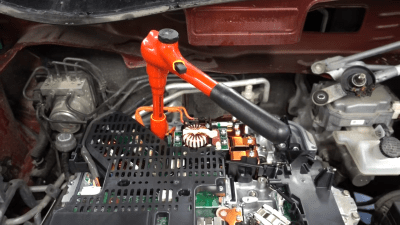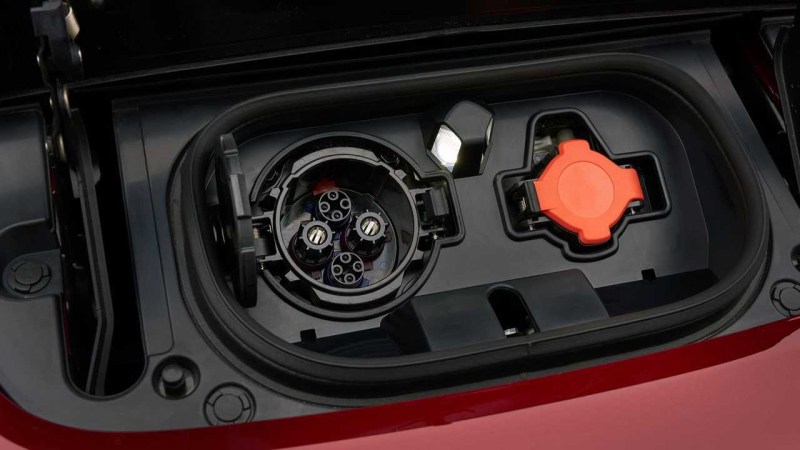Electric cars have been around for a while now, and thus they’re starting to get chopped up and modded just like any other car. [Daniel Öster] is one such person doing the work, and recently posted his efforts to retrofit fast charging to an base-model Nissan Leaf that didn’t ship with the feature.

The swap required the power distribution unit to be replaced, and the CHAdeMO port to be installed in the front of the car. The vehicle control module (VCM) also had to be opened in order to run a wire to a relay to activate the fast charging subsystem. Finally, wires had to be spliced to get everything to play nicely between the car and the fast charger.
[Daniel] had the benefit of quality forum resources and a Nissan Leaf that already had CHAdeMO to reference, which helped a lot. At the end of the day, the fast charger worked first time, much to [Daniel]’s relief. We’ve featured his work before, too. Video after the break.
















Safety Third.
Which is not to denigrate this project at all. If safety were truly first, nothing worthwhile would ever get done.
If you mean modifying a car is dangerous, yes, including internal combustion, mechanical parts, stereos, hydraulics, windshield wipers, headlamps, and everything else attached to the car. Everything can go wrong and end up costing you your life or the lives of others. Cars are dangerous. You’re better off not getting in one.
I think you’re completely missing the point.
Safety Third is a celebration of things that at first glance appear to be ill advised, but if done with the appropriate level of care are worth it.
Safety, while almost certainly in the top 5, should never be first, or you’ll never get anything done.
Dangerous? Very! That’s why he’s a professional (this is for a paying customer) with the appropriate knowledge, tools, and application of safety. Note that in the article and in video he points out he has the appropriate (expensive) tools and you shouldn’t even think about doing this without them. In the end, he recommends you just buy another car instead of doing this retrofit.
I refer the honourable gentleman to the answer I gave some moments ago.
Safety implementation is best hazard and risk based. This project looks pretty benign, where there is a manageable shock risk, but most is damage to the car should a short occur. It’s not playing with tigers or designing a nuclear processing facility from the ground up (that you your self might have to work in) – which both could be conceived as riskier things to do. But also possible and certainly wouldn’t be acieived if safety was the only thing being considered.
So yes, I’d agree more with a robust safety 3rd view rather than the school teacher esk safety 1st that’s often spouted without much substance to back it up (this is not aimed at anyone here or anyone’s comments – just years and years of existig). However, having seen this arguement play out a good few times, more concluded – let’s do the thing proving it can be done adequately safely. This makes functioality lead, while gating it with sufficiently escalated safety provision until it’s OK to do.
It gets rid of the numbers and usually stops people argueing about ranking where it goes in a list. Let the flame war of rankings commence:
I concede the point to my honorable colleague and apologize for an incorrect interpretation of his post. Indeed, that this video shows work done by a professional taking a well-considered risk, not a mere amateur taking an ill-advised risk.
4:53 Ignition relay” that sounds scary. what does it ignite??
Nothing. That’s just the guy you ask to hand the lit torch to another guy who does the dirty work. A kind of middle man so you have plausible deniability.
It’s like “passing the buck”, except it’s on fire :-)
I’m guessing it’s a holdover from ICE cars, the relay that closes when you start the car (i.e. “turn the ignition key”).
Those poor EV pixies.
I’m surprised you can even swap parts around in an EV, that it isn’t locked down in software every which way.
The Leaf is a first gen car, where locking things down isn’t high on the list. Just give it time. You can’t really do the same thing on a new Tesla for instance (first gen Teslas were more open, but not anymore).
Due to the recent global thing that shall not be named, the Prius sat for many months wothout moving. It’s 12V battery went flat which was easy to sort, but even somit wouldn’t start – reporting add fuel. Which was odd, as there was some in the tank. Threw in another 5l can and nothing happened before realising the main traction battery might be empty. While the graphic didn’t appear to indicate this, a little googling highlighted this as possible.
Some faff later, the top of the battery connectormcover was off which gave access to the back of the contactors for the output of the battery – seeingly unprotected doom – 200V battery and maybe no fuse!?
Charged it with a 400V bemch psu up to 90% SOC on trickle over a couple of days to let any cells passively equalise and good to go.
Yes, lots of safety was implimented.
Wish i’d added a charging port to it years ago as a whim.
Mine, which is 12 years old now, thanksfully did not had this problem, but i had to use it about once a week to go buy some food, which was probably enough to prevent traction battery to fully discharge.
But i had the 12V battrey going flat a few times, and it is very annoying to not be able to power on the car because of that, even if the high voltage traction battery is full!
I would like to have charging port on my car, but without additional batteries, it would not be very useful.
Slightly OOT, i’ve switch to 100% E85 fuel since a few years now, and appart the motor warning light stuck on (ODB “ENGINE TOO LEAN” error), it works pretty well. Too bad that Toyota doesn’t provide an official way to use it.
European Leaf owners may be interested to learn that Dutch Leaf experts Muxsan are close to releasing a CCS2 conversion kit that they’ve already tried on a Nissan e-NV200 van with upgraded battery.
Yes, but at nearly 5,000, it is extremely steep and is it worth it. May as well but a car with the CCS built in.
At that point, I’d just sell the Leaf and buy one with CHAdeMO built in.
Here in the US, I had a 2011 LEAF which had CHAdeMO DC fast charging from the factory. The problem was that CHAdeMO fast chargers are virtually non existent where I live. I believe the closest one is at an Electrify America installation over fifty miles away.
Anyway, the 2011 LEAF had what I would call a Byzantine setup with the rectifier/inverter located in the rear of the car with coolant lines running all the way to the inverter, traction motor and radiator loop up front. There was a separate liquid loop with PTC heaters to warm water for the cabin heater core. As far as I know, the excess heat from the electronics was not captured to keep the cabin warm. There were a total of three electric water pumps. The electronics got two pumps plumbed in series: one under the battery and the other on the passenger side fender. I had one of the pump tachometers go bad, giving an OBD error message “PWM output stuck HI.” The CPU sent the remaining pump into overdrive. The Nissan official shop manual outlined an icomplex service procedure requiring draining, filling and burping the coolant system which would have meant hours of labor. I thought it over and simply clamped the hoses on either side of the failed pump, dumped the coolant from the old pump into the new pump, reattached the hoses and bolted the new pump down. I did the job in under half an hour; with experience, it would probably be a 15 minute job.
The latter LEAFs simplified matters by making the electronics more compact and moving the DC-DC converter to the front of the car.
There are some other things to think about with the LEAF high voltage system. For example, contactor inside the HV battery pack has a limited number of cycles. The control electronics keep track of the number of cycles and if the contacts are opened under high current load. I am not sure what happens when the contactor is deemed worn out. On the 2011 LEAF, servicing the contactor would mean dropping the quite heavy and large battery pack.
Ultimately I sold off the LEAF because parts proved to be very expensive and all the dealings with the car were rather labor intensive. Ultimately, it was the lack of local CHAdeMO charging which was the deciding factor. I swapped the LEAF for a Chevy Bolt which has CCS, which is fairly abundantly available here. The Bolt’s HV battery has about three times the KWH capacity to boot, which has reduced my need to find public charging to the point where I’ve only used a public CCS DC charger once in the last four years
So given Gridserve have bought Ecotricity, and are removing all the charge points and replacing with ONLY CCS… How can one upgrade to CCS? That is probably more relevant today.